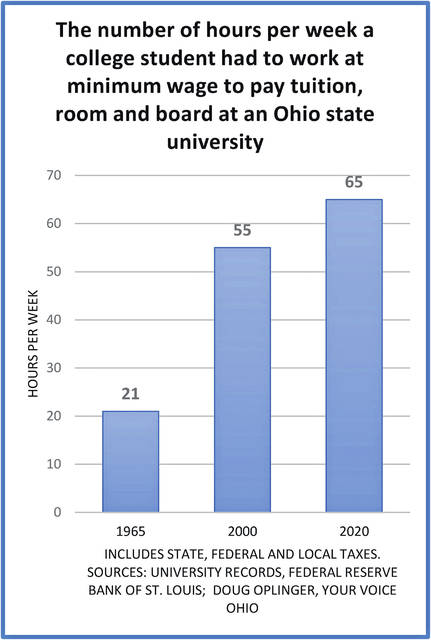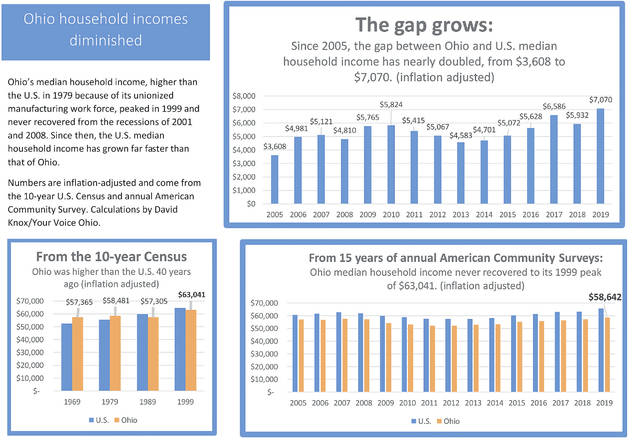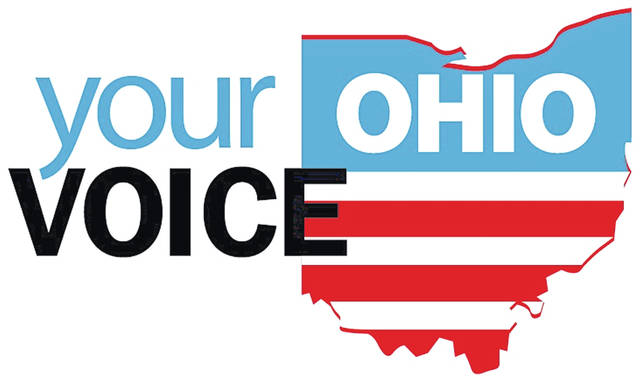



When the casino where Jessica Hamilton worked shut down for three months due to the novel coronavirus, she filed a claim for unemployment.
“I was on unemployment, which I never expected to be in my whole life,” Hamilton said.
She wasn’t alone. More than 1.6 million Ohioans filed claims with the Ohio Department of Jobs and Family Services during a 22-week period in 2020. That’s one in five Ohio workers and more than the combined total claims from the last four years.
The sudden spike in demand stretched the already thin unemployment-benefits system past its breaking point. Low on money to pay the claims, short on staff to answer calls and suffering from aging software, the system struggled. Thousands of Ohioans tried for weeks to just hear a voice, let alone receive benefits for food, housing and health issues.
Deferred maintenance on the system that is supposed to be a safety net for Ohioans was one of several issues of long-term neglect or indifference raised by voters during a week of remote meetings with Your Voice Ohio, a project that connects journalists with voters from across The Buckeye State. Their backgrounds, ages and education were diverse, but the voters interviewed overwhelmingly saw places where Ohio failed to invest when times were good only to find itself scrambling when the pandemic transformed these issues from disappointing to dire.
“I think it’s been magnified, a little bit, by the pandemic because, I mean, let’s face it there’s a lot of people who have lost jobs, who have been laid off; a lot of people who have more pressing needs … ,” Worthington resident Dave Harliss said. “We have to have long-term goals as to how we are going to stay the best country in the world to live in, and if we don’t, it won’t happen. It maybe has become a little more urgent, but it’s really no different.”
Paid sick leave
For Hamilton, making it possible for people like her to stay home when they test positive for COVID-19 was one of issues she wanted addressed at both the state and federal level.
What can people do, Hamilton asked, when they have five days of sick leave but health officials recommend quarantining for two weeks. She wanted a real answer from politicians and “not just, ‘Oh hey, your company will take care of that.’”
The federal Families First Coronavirus Response Act created emergency protections for certain private sector employees if they had to quarantine “pursuant to federal, state, or local government order or advice of a health care provider.” But the bill didn’t include employers with more than 500 or less than 50 employees.
At the state level, Ohio’s Republican-controlled legislature left paid sick leave provisions out of its own coronavirus bill passed in late March.
“There really is nothing for her to do, and that’s a horrible answer for me to give as a politician,” House Minority Leader Emilia Sykes, D-Akron, said after hearing of the dialogues. “These are impossible choices that folks are left with.”
About 90% of Americans admitted they go to work sick some of the time, according to an October 2019 survey by the global staffing firm Accountemps. And 33% reported always going when they were “under the weather.”
“They can transmit diseases. They can make themselves sicker for fear of not having any paid sick time,” said Gladys Pope, an elementary school secretary from Cincinnati. “I know the pandemic has sort of pulled back the cover on that initially, but I feel like that kind of has gotten buried under the economy and vaccines. I think that’s a conversation we need to pull back to the forefront.”
Bringing jobs back
Dominic Bunn chose not to enter the workforce when he graduated this spring. Instead, he packed up and moved from Rochester to North Ridgeville to attend graduate school at Case Western Reserve University.
But that doesn’t mean Ohio’s job market isn’t on his mind.
“I’d like to hear plans about how they intend to bring sustainable jobs,” Bunn said. “You can talk about revitalizing different industries, but I mean the industries left for a reason. And I think we should talk about bringing jobs that are going to stay here for 10, 20, 30, 40, 50 years.”
Ohio’s unemployment had dropped from 5.2% when President Donald Trump took office to 4.1% before the pandemic, according to state labor statistics. But job growth had slowed in the kind of blue-collar manufacturing jobs the president promised voters. In fact, Ohio manufacturing jobs plateaued one year into his first term and were in a downward trend before the pandemic, according to seasonally adjusted data from the Bureau of Labor Statistics. Some experts predict the state will lose another 40,000 manufacturing jobs (nearly 6%) by 2026.
“I came here to Cleveland in 1991 as a result of the steel industry disappearing in Pittsburgh,” Richard Madonna said. “The one thing Pittsburgh has done is they’ve revitalized it. They tore it down and started over.”
But Madonna sees “miles of abandoned mills” – including the well-known General Motors plant in Lordstown — decaying throughout northeast Ohio. Cleveland now ranks as the fifth fastest shrinking large city in the U.S., and the state as a whole is expected to lose at least one congressional seat after the 2020 census.
“I think for a lot of Ohio’s history our economy has been fairly reliant on certain industries such as manufacturing,” said Spencer Fritz, a student at Sinclair Community College. “So, when the economy has gotten bad and we’ve lost many of our manufacturing jobs, we’re in a position where we are not able to recover as easily.”
And that, the psychology major said, pushed people into minimum wages “that they can’t live off of.”
Voters in every group worried about the declines they’ve seen in livable-wage jobs. One Dayton resident called fair wages and affordable housing Ohio’s most important economic issues.
“I do a lot of community work and I see how people’s lives are changed when they have those things — when they can pay their bills, have grocery money and live in a safe place and not be house poor,” Pope said. “That could change the shape of our state’s economy.”
Ohio’s median income peaked in 1999 at $63,041 a year when adjusted for inflation, according to data obtained by Your Voice Ohio. Today those households makes about $5,000 or 7% less. Pope’s home county saw a steeper decline. Median income in Montgomery County was about $10,000 a year less for 2019 when compared with 1999.
And Ohio has tumbled in relation to the nation. In 1999, median household income was about 2.4% below the U.S. median, but by 2019 the gap had more than tripled to 9%.
Fritz wanted to see more jobs in STEM fields like medical technology and engineering come to Ohio.
“I think what’s best for our economy is to be able to have more options, to diversify,” he said.
One idea Madonna floated was to manufacture personal protective equipment or PPE here in Ohio. That’s something both presidential candidates have pushed. Trump invoked the Defense Production Act back in March as a way to pressure GM into manufacturing ventilators at its Lordstown plant.
Bunn liked the idea for the short-term, but said Ohio needs industries that employ people both with and without college degrees for the long-term.
“If we don’t start dealing with that now,” Bunn said. “I’m not sure we are going to be able to deal with it.”
Fellow student, Mia Toomer, agreed. The Youngstown State University student wanted more than just a promise. She and her friends need specifics if they’re going to stick around after graduation.
“They can say, ‘Oh, I’m going to bring more jobs. I’m going to make America great. I’m going to do this,” Toomer said. “But How? What are your plans?”
The rising cost of education
Madonna and others were quick to point out that luring companies to Ohio would require a labor force with the skills to fill those positions. But both Ohio and the U.S., they said, haven’t done their best to de-stigmatize a trade school education or make college more affordable.
“A lot of students, high schoolers, they don’t want to go into college because they don’t want to take on student loans,” Priya Kumar said. “That’s a huge chunk of the population that is discouraged in a way because they will have to pay this much.”
Most Americans (61%) wrongly believed state spending for public universities and colleges increased or held steady from 2008 to 2018, according to an American Public Media Survey.
In reality, the Center on Budget and Policy Priorities found U.S. states collectively spent about $9 billion less than they had in 2008. Ohio was no exception.
As an example, Sykes said it was cheaper for her to get a law degree from the University of Florida than it would have been at The Ohio State University. And that’s problematic for a state that wants to keep its talent at home.
More than 40 years ago, Ohio subsidized about two-thirds of the cost of college. Today, it’s far less.
For example, in 1965, a person could work 21 hours a week at minimum wage and have enough to pay tuition, room and board at a state university. Today, a person must work 65 hours a week at minimum wage, every week, no vacations, to afford the same, according to Your Voice Ohio calculations.
It’s hard to focus on school, Fritz said, when you’re worried about how you’ll pay off loans for the rest of your life.
Especially when there’s no job for them after graduation, Ashley Francois said. The Columbus resident knows “so many people” who can’t find jobs despite having a college degree.
One solution floated in almost every listening session was to increase high school classes in vocational trades like heating and cooling, autobody repair and plumbing as well as post-secondary trade schools.
“I went to vocational school in high school and learned a trade in that two years, and I retired from a job I worked at for 46 years,” Hamilton Ohio native Richard Cornelius said. “The building trades especially right now are really hurting right now, needing people to work. You can make a good, living wage doing that. I never did understand why they stopped doing that.”
Vocational training dipped nationally in the 1980s and 1990s, but numbers from the National Center for Education Statistics show a steady rise in enrollment during the last two decades.
Internet access
Nearly one in 10 Ohioans lacks reliable access to high-speed internet, according to data from Innovate Ohio, the state’s broadband initiative.
Connecting folks in both rural and urban areas was an issue Republican Gov. Mike DeWine campaigned on with Lt. Gov. John Husted in 2018. And giving government grants to pay for part of those new lines is something Republican Rep. Rick Carfagna has worked on since 2017.
“When we campaigned on it, it was important,” Husted said. “Now, I would consider what COVID has done is advanced it to make it critical.”
Ohioans with access to the internet can register to vote, file for unemployment, work, learn and even meet with their doctors due to the pandemic. And the folks without access in their homes also saw their internet hotspots such as restaurants and libraries shut down.
It’s a reality voters in rural areas and economically disadvantaged urban neighborhoods have known for a long time.
“Technology is something I don’t hear either candidate talking a lot about,” Middletown native Marc Morgan said.
Morgan, who worked for the Republican National Committee under Michael Steele, said he wanted to know how candidates at the state and federal level are going to make sure kids and communities have the infrastructure and skills necessary to compete on the global stage.
“It’s like not having a road,” Husted said. “You’re not going to put a warehouse distribution center in a place where there is no highway.”
The lieutenant governor has worked to remove some of the regulatory red tape that made it more expensive and time consuming to lay a mile of cable. But ultimately, he said, it comes down to money. Companies don’t lay lines where they don’t see a profit.
Both he and Carfagna support a bidding process where companies say how much they would spend and the state makes up the difference for the best bid. House Bill 13, which would dedicate $20 million toward a grant system, passed the House in June.
But as thousands of Ohio households – and school children – struggle in an ongoing pandemic to connect via the internet with school, work, doctors and more – there has been no action on the bill since mid-July and it has until Dec. 31 to get through the Ohio Senate or it will die.
How to pay for it
Deferred maintenance in a home, a city or even the state legislature often happens because people simply lack the money. And borrowing during a crisis – while sometimes necessary – can push items like fixing a leaky sink further down the list.
But governments also have the power to change their income, and often do so for the programs lawmakers choose to fund, such as a recent gas tax increase for highway construction.
The unemployment fund is supposed to be self-sustained through payroll taxes, but federal regulators say Ohio hasn’t met the minimum requirement of a year’s worth of reserves since 1974. Twenty-nine other states hit that minimum between the Great Recession and the pandemic. Ohio did not.
“You know, you just don’t print $1 trillion. You don’t print $3 trillion … ,” Madonna said. “If you listen to the radio at all, doesn’t matter what station you listen to, the national debt for the year has as already overcome the GDP. We’ve got to pay the piper. We’ve got to get through this. We’ve got to help our brothers and sisters, but it’s really going to hurt us in the future.”
But Pope, the Cincinnati school secretary, said leaders need to listen to how people are able to agree on what is needed to improve life.
After her group shared about the need for child care, education, health care and living wages, Pope observed: “It’s also very interesting that while we are from different parts of Ohio, and we have different jobs and different backgrounds, that we are pretty much all in agreement on these things. I hope that legislators in Ohio are listening to the people, because I find that when I’m in groups of Cincinnatians and Ohioans, we are all saying we are in agreement on the same things. That shows us that we have some solid ground that would make our state better.”





